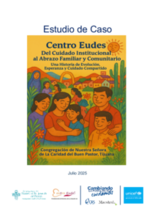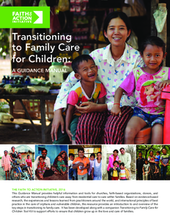The aim of this stage is to implement the new services that have been designed in consultation with a range of stakeholders and by doing so, increase families’ access to community and family-based supports. This might be in support of reintegrating children or of children and families in the area surrounding the former institution (where the buildings have been repurposed) or in a new area where needs have been identified.
This stage is concerned with implementation of new services and turning the program plans and frameworks into action.
Activities that may occur during this stage include:
- Recruitment of new personnel
- Upskilling staff in relevant technical or management skills in preparation for implementing new programs
- Further training or induction into new systems and processes
- Repurposing facilities and assets
- Launching and piloting new services
- Intake, enrollments or accepting referrals
- Developing new communications resources to promote the new services amongst donors and for advocacy purposes
- Conducting monitoring and seeking feedback to improve and adapt services
- Capturing learning and stories
Key milestones associated with this stage include:
- New services/initiatives operating
- Learning is being captured and used to continue to shape and improve new services and to share with others
- The organization’s capacity has been strengthened in preparation for running new services
Resources
Displaying 1 - 6 of 6
Este documento es un estudio de caso basado en la historia de transformación del Hogar Esquipulas, liderada por la Asociación de Religiosas Franciscanas de San Antonio en Esquipulas, Chiquimula, Guatemala, representa un testimonio inspirador del compromiso profundo con el bienestar de los niños, niñas y adolescentes.
This case study showcases Kar Geno’s transition from institutional care to community-based support for children with disabilities in Siaya County, Kenya, guided by CTWWC and Catholic Relief Services. Through family reintegration, disability-inclusive services, and strong collaboration with government and civil society, Kar Geno has become a model for sustainable care reform, reintegrating nearly all resident children while continuing to provide accessible medical and psychosocial support through a community drop-in center.
Desde Tijuana, este relato muestra cómo una comunidad religiosa, las Hermanas de Nuestra Señora de la Caridad del Buen Pastor, decidió pasar de un modelo institucional de cuidado a un enfoque centrado en las familias y la vida comunitaria, priorizando el derecho de cada niña, niño y adolescente a crecer en un entorno seguro, amoroso y protector.
The purpose of this webinar was to launch the tool, provide background information on its development, the analysis that underpins it, and conduct a virtual walk through of the tool.
El propósito de este seminario web fue lanzar la herramienta, proporcionar información de antecedentes sobre su desarrollo, el análisis que la sustenta y realizar un recorrido virtual por la herramienta.
The story of Heartline’s transition from residential care to family care is told in this recently released Faith to Action case study. The case study details their experience through three stages of transition—learning, preparation and planning, and full transition—with transparency. It addresses common challenges for transitioning organizations, as well as the strategies Heartline took to overcome them.
Transitioning to Family Care for Children: A Guidance Manual aims to provide practical guidance and tools for churches, faith-based organizations, donors, and others who are transitioning care for children away from residential care to care within families.





